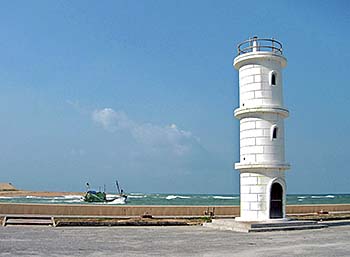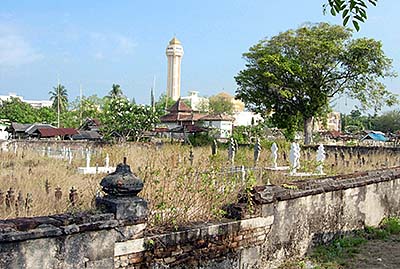Kuala Terengganu
A place at Malaysia's sleepy east coast, Kuala Terengganu is no more as small as one would think. Expanding 400,000 inhabitants, it became city status granted in 2008. The population is dominated by around 95% of Muslim Malays.

The coastline and beaches of Kuala Terengganu, close to the city center. Image by Asienreisender, 3/2005
Situated at the mouth of Kuala Terengganu River at the coast of the South China Sea, several long sand beaches with bays and coastal plains invite visitors for a stroll around. There are some more rivers in the district who drain here into the sea. The sea here can be very rough in rainy season. Partially, the coastline is overgrown with mangrove forests. Further west, apart from the sea, some hills arise, not extending a height of 500m, 600m.
Kuala Terengganu's economy is coined by agriculture, fishing and textile trade. Tourism is of minor influence, for most tourists just pass through here on the way to the Perhentian Islands.
The place has a long historical record, and is first mentioned by Chinese seafarers. It became a tributary of two Chinese dynasties, until it fell under the dominance of the Srivijaya empire in Sumatra. After Srivijaya's decline, the area got under dispute of three other powers, that was the Sultanate of Malacca, the empire of Majapahit and the Siamese empire of Ayutthaya. Malacca proved to be the dominant power for a time until the Portuguese captured it. Malacca's successor in rule over Kuala Terengganu was then the Sultanate of Johor, what lasted until the end of the 17th century.

Strolling around in Kuala Terengganu, I can't deny it's a pretty boring place. That is so for all the places along Malaysia's east coast. An attraction is already a Muslim cemetery. In the background (and in the bar left) we see a mosque tower who provides the necessary sound services. Image by Asienreisender, 3/2005
When Kuala Terengganu eventually became an own Sultanate in 1708, it was still a small place with around 1,000 houses scattered around the hills along Kuala Terengganu River. Half of the population was Chinese then. In the second half of the 19th century the British sent three warships and bombed Kuala Terengganu, for the Sultan gave shelter to an influencial man named Wan Ahmad, who repeatedly attacked and interrupted British trade along this section of the coastline. In 1882, the place got widely destroyed by a disastrous fire. The place came in it's versatile history again under the dominance of foreign powers, first the Bangkok-Siamese and then the British colonial power from 1909 on.
Nowadays, the place is booming as any other place in Southeast Asia, and has at least a modern appearance. High, modern concrete buildings coin the skyline and several universities and health institutions are established in Kuala Terengganu; it has also an airport. From the bus terminal go and come buses to and fro all major Malaysian cities and Singapore. A local bus service is running as well. There is the state museum and a big library here. A small Chinatown (Kampung Cina in Malay language) consists of some classical Chinese shophouses of who a few date back to 1700. Dont' worry about mosques - there are plenty in town.